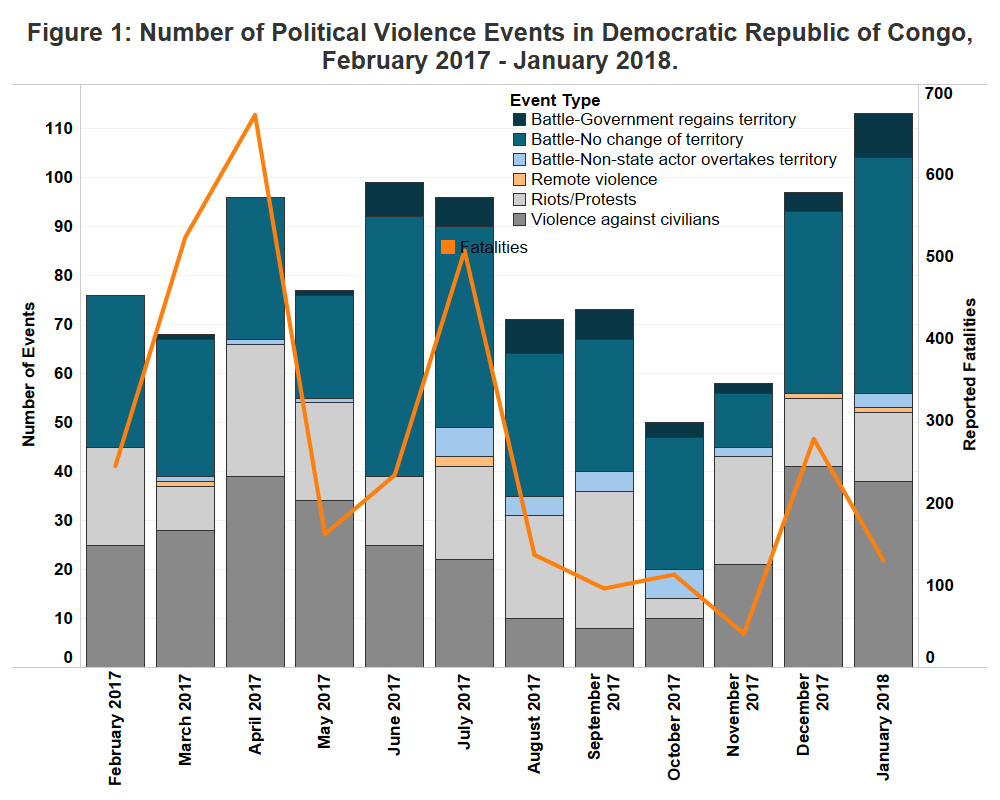In DR-Congo, signs of a perfect storm are emerging: local conflict is flaring in the North East, continued demonstrations are occuring in urban areas, state repression of protesters is leading to increased fatalities, new militia actors and coalition are forming and joining with typical violence agents, international security groups are being targeted by rebel organizations with lethally disruptive intentions, and diplomatic tensions are ongoing. It is clear that the state cannot handle the multiple threats (many of its own making), and the security and governance vacuum in the East has resulted in a proliferation of groups.
Tensions flared and protests emerged nation-wide when the previously agreed upon deadline of December 2017 for the presidential election was not respected. Militia activity remains at the center stage of political violence: across the last 12 months, political militias were involved, on average, in one in every two occurrences of political violence.
A temporal pattern has emerged in that time: while activity increased in March-June and October-November, the variations experienced were not abrupt. In contrast, violence against civilians experienced a constant increase from February until April, followed by a decrease until September and another almost constant increase until January (see Figure 1). The trend after September coincides with the experienced political tensions leading up to the deadline of Kabila’s presidency, and the repression of civilian protests in an attempt to silence opposition. When the National Election Commission adopted a new electoral calendar in early December, postponing presidential elections for December 2018, civilians protested this decision nationwide. Seen as civilian disobedience, (protests had been banned by the government), these actions were countered with enhanced police activity – and in some cases, violent repression by security forces.
The number of fatalities spiked in April 2017 at almost 700. The majority of these were civilians deaths, which occurred at the time of nationwide protests. The number of fatalities has since decreased, but remain high at over 400 dead civilians, and in December with 35 civilian fatalities. This increase coincided again with Kabila’s postponement of the presidential elections.
Militia activity increased in a steady manner since November 2017, reaching its peak in January. Yet much activity has concentrated on the ADF, regarded as the perpetrator of the attack on Semuliki in North Kivu that killed 15 MONUSCO soldiers on the 8 December 2017. On 12 February, the FARDC recovered the ‘grand bastion’ of ADF in Mwalika. Nevertheless, violent territorial disputes in the Mbanu-Kamango-Eringiti axis continue between the FARDC-ADF, which signals a need to ensure territorial control of a strategic area.
Clashes in the Kivu provinces continue to increase, creating worry that the activity by both state and non-state actors has entered a dangerous phase with clear spiralling (see Figure 2). The Mayi Mayi Yakutumba also increased their activities in January, as well as the FRPI. In February, interethnic violence between the Lendu and Hema groups led to 60 fatalities in less than one week, causing unrest among the local population and leading to humanitarian concerns. Additionally, a diplomatic spat has emerged between the Congolese and Rwandan governments, as Rwandan forces are accused of having penetrated DRC territory, and killing 10 FARDC soldiers during a clash in Virunga National Park.







